The ASUS X399 ROG Zenith Extreme Motherboard Review: Top Tier Threadripper
by E. Fylladitakis on July 17, 2018 10:30 AM EST- Posted in
- Motherboards
- Gaming
- Asus
- ROG
- Overclocking
- ThreadRipper
- X399
Visual Inspection
At first sight, the ASUS X399 ROG Zenith Extreme does not appear to be aesthetically extravagant. It is built on an all-black PCB and black/grey plastic and metallic parts create a subtle visual antithesis. This changes quickly once the motherboard is powered on, as ASUS installed RGB lighting brightens up on the I/O cover, at the chipset, and on the right back side of the motherboard. There is also a small OLED screen on the I/O cover and several small LEDs on the motherboard for diagnostic purposes. These small LEDs quickly indicate if there is an issue with the CPU/RAM/VGA during boot, allowing the quick troubleshooting of boot-related issues, especially when overclocking. ASUS even installed a standard HDD activity LED on the PCB, just to the right of the chipset's heatsink.
For those that do not find that much RGB lighting to be enough, the ASUS X399 ROG Zenith Extreme has three RGB LED headers onboard as well. Two headers support standard 5050 RGB 12V strips, with ASUS recommending not to use strips longer than two meters. The third header is a digitally controlled header for WS2812B addressable strips and does not support regular 12V/5V LED strips.
The VRM circuitry of the ASUS X399 ROG Zenith Extreme is on par to that of any other AMD X399 motherboard we reviewed before, with an eight-phase digital VRM circuitry for the CPU plus a supportive three-phase VRM for the CPU's SoC. The main difference here are the components and their power ratings. For the main eight CPU phases, ASUS is using International Rectifier (Infineon) IR3555M MOSFET drivers that are rated for 60A each, which are controlled by an ASP1405 Digital PWM controller. There is no information regarding the ASP1405 controller but it can be found on several and much older ASUS motherboards, so these chips almost definitely are other controllers that ASUS rebrands to their ROG family standards. Each phase also has a "MicroFine Alloy" inductor, which also are currently used only by ASUS and their specifications are unknown to us.
Four power connectors are required for the ASUS X399 ROG Zenith Extreme. It requires the standard 24-pin ATX connector, two 12V CPU 8-pin connectors, and a single 4-pin Molex connector that is subtly hidden close to the right bottom edge of the motherboard. This final molex connector is used when multiple PCIe devices are installed at once. ASUS also installed voltage probing contact points next to the ATX connector, allowing the checking of several critical overclocking settings (Vcore, Vdimm, Vsoc, etc.) using a multimeter. ASUS's approach isn't foolproof - the manual offers very vague and limited information regarding how this works, assuming that the user knows how to setup and use a multimeter. It is very easy for an inexperienced user to set the multimeter wrong and permanently damage the processor or the motherboard during this process - all it takes is to use the ammeter instead of the voltmeter connections and the short-circuit will most likely destroy something.
The heart of the audio circuitry is the Realtek S1220 controller, which is a custom variation of the well-known ALC 1220 chipset. There are no apparent differences between the stock ALC 1220 and the S1220, as both chipsets have the same exact specifications and even physical appearance. It was erroneously reported in the past that the S1220 lacks i2S output but that is obviously not true with the ASUS X399 ROG Zenith Extreme, as an ESS Sabre 9018Q2C DAC is present and connected to the i2S interface. ASUS is using the well-known Nichicon Gold audio-specific capacitors that we find on every advanced motherboard. The left-right channels are isolated from each other on separate PCBs and the whole audio circuitry is also isolated from the rest of the motherboard, minimizing any interference and maximizing the dynamic range of the audio circuitry.
The cooling of the motherboard is more complex than what it first appears to be. Two sizable heatsinks that are interconnected via a heatpipe cover the motherboard's main VRM circuits, with one of them hidden beneath the plastic I/O shield. The plastic I/O shield also hides a small cooling fan that provides constant active cooling. By default, this fan is quite loud but it can be tuned via the BIOS or the provided fan control software. The I/O shield also has a small OLED screen installed on it. The OLED screen is programmable and can display information about the system, such as the CPU's clock speed or a temperature reading, or purely cosmetic items like simple monochromatic artwork. Its size and placement make it useful only in very specific situations, as it is impossible to read it with the motherboard installed in a large case without direct line of sight and from a close proximity to the windowed side panel.
The southbridge heatsink appears simple and sizable, which should be enough to cool the AMD X399 chipset, even if overclocked. However, there is a quirk here - the heatsink also hides one of the M.2 drive slots and doubles as a heatsink for the M.2 drive installed there. Although we would normally welcome the additional cooling for the M.2 drive, sharing the same heatsink with the chipset is not a particularly good idea, as the heatsink is not large enough to warrant low operating temperatures for both devices. For example, stressed SSD can easily cause an overclocked chipset to overheat and cause system-wide instability. ASUS has a thermal sensor installed on the M.2 drive area, allowing the monitoring of the drive's operational temperature and the diagnosing of any thermal-related issues.
Despite the E-ATX form of the motherboard, ASUS's engineers had no space to place more M.2 drives on the PCB, so they transferred the other two M.2 slots onto a vertical daughterboard. ASUS baptized this daughterboard "DIMM.2", a witty combination of the "DIMM" and "M.2" designations, as it resembles a DIMM module. This approach offers two major advantages: it allows for the very easy installation/removal of M.2 devices, as it is very easy to remove the whole daughterboard from the system and work on it, and it offers much superior cooling for the M.2 drives as it has a slot for an optional 60 mm fan. The installation of the fan requires using the small metallics corners that are supplied alongside with the DIMM.2 card. The DIMM.2 card also has two headers for normal k-type 2-pin thermocouples.
The ASUS X399 ROG Zenith Extreme has six SATA ports, a downgrade from the usual eight that we commonly see on Ryzen Threadripper motherboards. Apparently, the company's engineers ran out of usable space close to the chipset and decided to sacrifice two SATA ports for a single U.2 PCIe ×4 port. The U.2 port shares its four PCIe lanes with another device but, unlike our initial expectations, they are not shared with those of a M.2 port but with the last full size PCIe slot. That means that a U.2 drive can be used even with all three M.2 ports populated but, on the other hand, installing four graphics cards will disable the U.2 port. It is obvious that ASUS thought that using all three M.2 ports is more likely than using four graphics cards. If a PCIe ×4 device is installed in that last slot, the U.2 drive will operate normally alongside with it.
For the wired network connection of the system, ASUS is using the well-known Intel I211-AT Network Interface Controller (NIC). ASUS has an anti-surge chip called "LANGuard" installed, protecting the motherboard from electrical disturbances that may appear in the data network. The 10G NIC is on a stand-alone PCIe ×4 card that is supplied alongside with the bundle, allowing the user to choose whether to install it or not. The ROG AREION 10G card is based on the well-known AQUANTIA AQC107 chipset. The wireless NIC of the motherboard is the Atheros QCA9008 AC+AD card, a newly released chipset that supports WiGig 4.6 Gbps connections. Note that WiGig is currently not supported in all countries. If no WiGig is available, the chipset supports 2x2 MU-MIMO 802.11a/b/g/n/ac connections with a maximum bandwidth of 867 Mbps. WiGig is supposed to support wireless VR in the future.
One unique aspect of the ASUS X399 ROG Zenith Extreme is that it has two additional PCIe slots, one ×1 and one ×4, in addition to the four full-size PCIe slots. Every other Ryzen Threadripper motherboard has only one extra PCIe device slot. The ROG AREION 10G card is partially to blame for the extra PCIe ×4 slot, as it would not make any sense to force users to install it in a full-size PCIe slot and block the installation of a graphics card. However, this creates a critical layout disadvantage, as the top slot is far too close to the CPU socket. It is not possible to install any card into the top slot if the CPU's cooler extends even a few millimeters below the socket, creating major compatibility problems. None of the three TR4-specific tower air coolers that we tested would fit without blocking the installation of the top graphics card. For users with a single graphics card however, the third full-length slot is perfectly suitable.
The rear panel of the ASUS X399 ROG Zenith Extreme has the I/O shield permanently attached to the motherboard. ASUS claims that this approach significantly increases the protection against electrostatic discharges. Two buttons are installed on the I/O shield, one for clearing the BIOS and one for the BIOS Flashback function. The BIOS Flashback allows for a BIOS to be updated without entering the current BIOS or the OS, an option ideal for dealing with compatibility issues. We can see a huge array of eight USB 3.1 Gen 1 ports, plus two USB 3.1 Gen 2 ports (one Type-A and one Type-C). There is only one LAN interface (Intel I211-AT). Finally, there are five gold-plated 3.5 mm audio jacks and one optical SPDIF connector. The 3.5 mm audio jacks feature color-coded illumination for those really dark under-the-desk places.
For those that require additional device connectors, the ASUS X399 ROG Zenith Extreme has four USB headers on board. Two headers provide two USB 3.1 Gen 1 ports each, one is for two USB 2.0 ports, and the last one is for a USB 3.1 Gen 2 port. Another two headers offer support for the ROG OC Panel that is purchased separately. There is also a TPM connector.
The ASUS X399 ROG Zenith Extreme is the only AMD X399 motherboard with hardware features for extreme overclockers and LN2 cooling. A jumper can be used to switch the motherboard to LN2 mode and bypass the cold boot bug. The "Slow Mode" switch will reduce the CPUs speed, allowing the system to remain temporarily stable during very extreme overclocking sessions. Two buttons are used to manipulate the BIOS, labelled "ReTry" and the "Safe Boot". The "ReTry" button forcefully restarts the motherboard if the reset button is not working but does not alter any settings, allowing to repeatedly test the motherboard using the same settings while hoping for the system to post. The "Safe Boot" button boots the motherboard using a safe BIOS configuration but does not alter any settings, allowing the user to fine-tune a borderline stable overclock. All of these options are most likely useful only to extreme and competition overclockers but may also help a casual overclocker quickly undo a bad setting that caused the system being unable to boot.


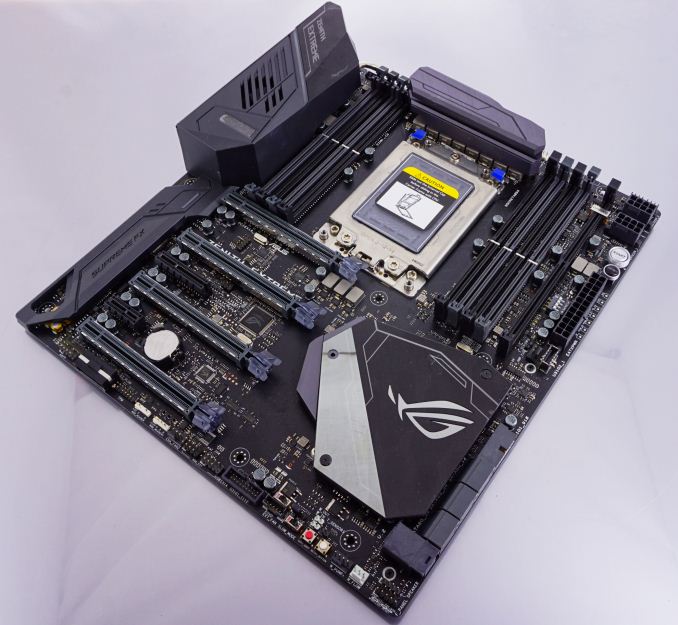
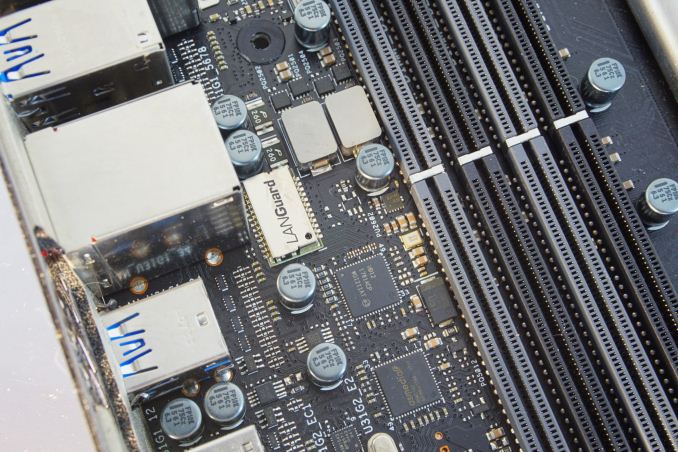
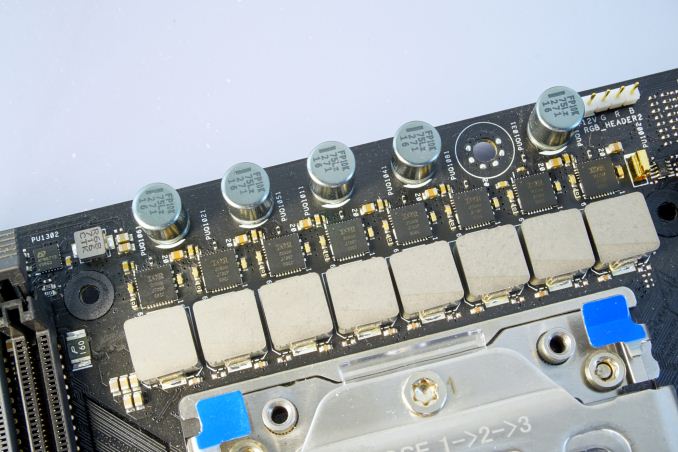

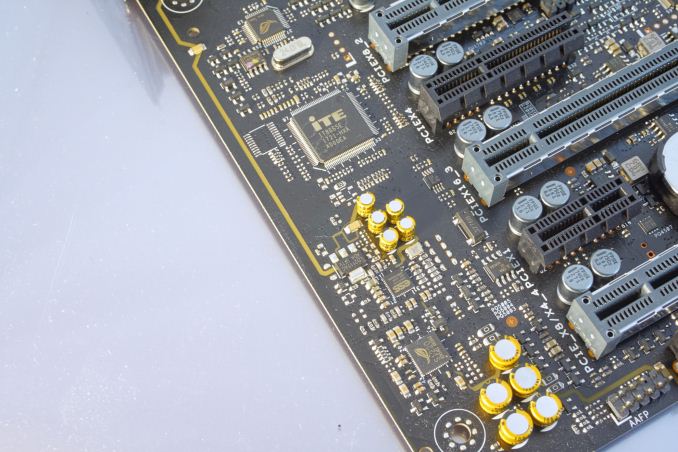
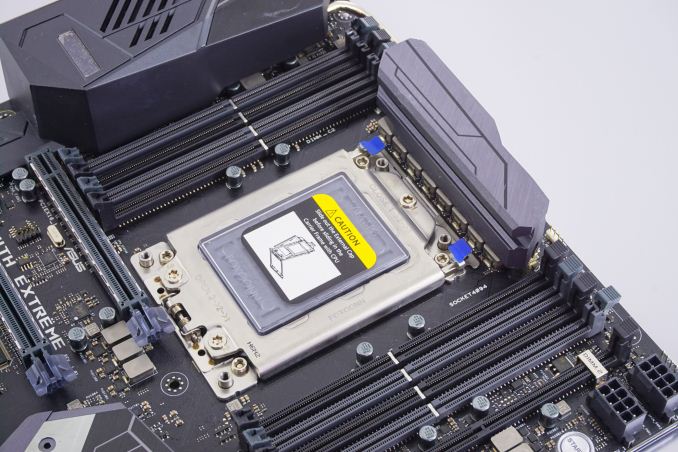
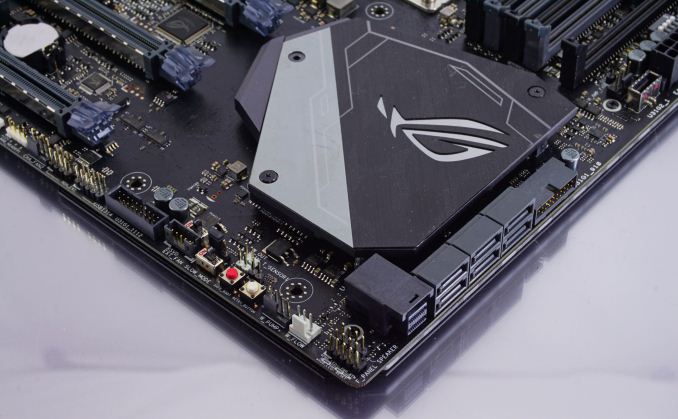

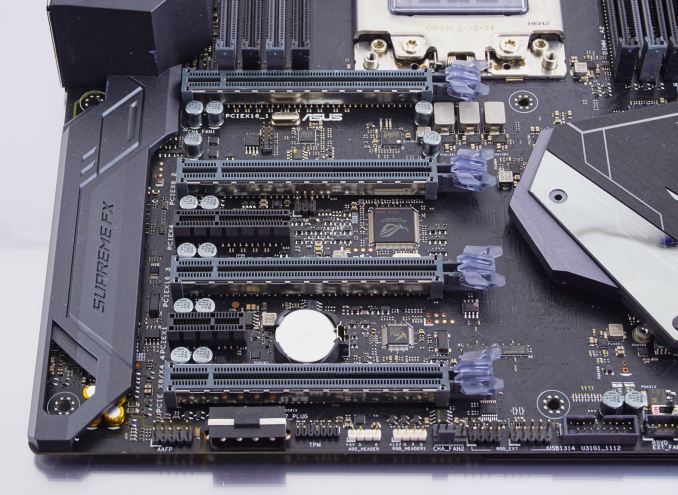
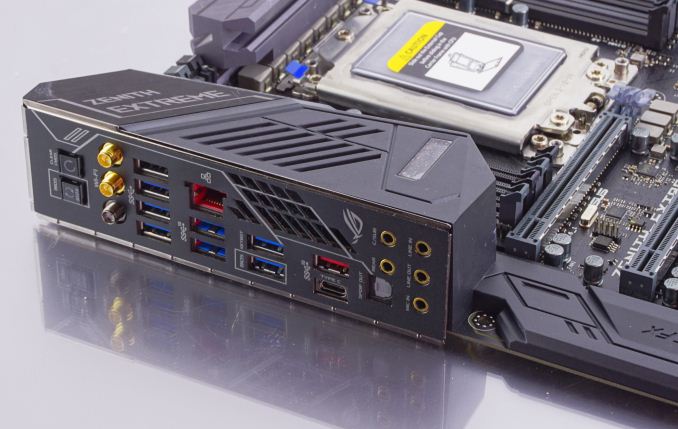








25 Comments
View All Comments
Meaker10 - Tuesday, July 17, 2018 - link
It's going to struggle to deliver power to 32 cores though.Chaitanya - Tuesday, July 17, 2018 - link
which is why expect to see a refreshed X399 boards from all vendors with launch of Threadripper 2.SodaAnt - Tuesday, July 17, 2018 - link
Small as it is, the VRM fan should help a lot with that.Oxford Guy - Thursday, July 19, 2018 - link
Meanwhile, ASUS showed up on the market with a hybrid air-water VRM solution back in 2013. We're supposed to get excited for teeny-tiny fans and rainbow LEDs — for a board that has stupid liquid nitrogen features. Yeah, water cooling is just so esoteric in comparison.Gothmoth - Saturday, July 21, 2018 - link
Nonsense... The VRM is fine for the 32 core threadripper 2.plonk420 - Monday, July 23, 2018 - link
*OCing on 32 cores :Peva02langley - Tuesday, July 17, 2018 - link
ROG? ROG!!!? I thought AMD was AREZ now.Asus, please explain to me how it makes sense... I am buying an AMD AREZ card, however I am using an AMD ROG motherboard. I am so confused... you were the one telling me I was too dumb to understand what I was buying, so you had to simplify it for me... and now I am just more confused than I was.
Congratulation Asus, you are making sense.
jordanclock - Tuesday, July 17, 2018 - link
AREZ was started because of Nvidia's GPP. Some manufacturer's, like Asus, took the route of making entire new brands for AMD, not just for GPUs. But because Nvidia finally caved and gave up on GPP, AREZ is no longer necessary.But you probably already knew that and know that AREZ/ROG has nothing to do with compatibility.
The Chill Blueberry - Wednesday, July 18, 2018 - link
AREZ is for Radeon; AMD is still ROG.jabber - Tuesday, July 17, 2018 - link
Would anyone who would buy such a board even bother to use the USB stick with what will be out of date drivers and added value junk on it anyway? Waste of time with USB or DVD/CD. Like driver disks in GPU boxes.